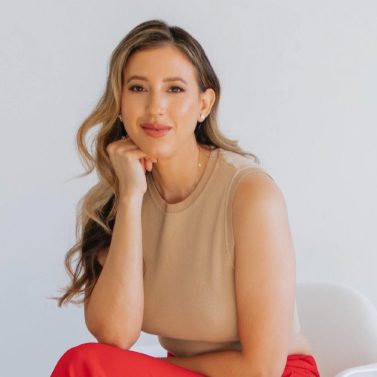What do you wish you had known before building or redesigning your website?

Vanessa Santos
Having Clear Brand Guidelines and User Personas
Your website is your digital fingerprint, an extension of you. A common mistake, and one I wish I had avoided, is that we often spend too much time comparing and looking for inspiration. The excitement sets in because you have all of these great ideas, and you rush to build a site that has all of the features that you liked from other sites. When you step back to look at your own site, you realize it’s not cohesive.
Having clear brand guidelines and user personas is key to building an effective and sticky website to properly showcase you and your business. Learning from this mistake I created a brand guideline for myself, set a clear set of values, and a mission statement for what I offer on my website. I also developed uniform assets that are used across all of my channels to create brand cohesion. Designing your website is fun. Yet, it can be overwhelming. So, I always recommend taking the time to build your brand guidelines before starting the design process.
The Importance of Website Speed
We were so focused on making our website aesthetically pleasing and enticing that we didn’t really factor in how much the razzle-dazzle would impact the site speed.
With Google’s repeated mantra on the growing importance of website speed, particularly for mobile, we initially suffered a significant drop in keyword rankings across the site, with our new site taking an average of three seconds to load. [It was] like having a Ferrari but keeping it locked in a garage. Nobody got to see it.
It took us a few weeks and a considerable amount of money to rectify this and lean out the size of the site so that it loaded in under two seconds. Once we managed to do this, our rankings regressed to the mean, and we started to enjoy a significant flow of organic traffic again.

Karl Robinson

Clovis Chow
The Importance of the Mobile Layout
I wished I’d known that the design for a laptop layout might not fit nicely for mobile and the importance of the mobile layout.
When I first designed my website, I designed it completely from a laptop layout. I did not bother checking the mobile layout. I thought that the website, or at least the theme I am using called Divi, would automatically shrink the page down to the size of a mobile phone nicely.
However, a few months later I realized that the spacing and design for the mobile layout was quite messy and ugly. Spaces were larger than usual, some pictures or widgets were overlapping with each other, and the website looked really untidy and unorganized.
A few weeks after I designed my website, I read multiple articles stressing the importance of the mobile experience and how many visitors access websites on their phones. The percentage could be up to as high as 70-80%. That was when I realized that not optimizing and organizing my website for mobile users was a huge loss in visitors and page views.
After tidying the mobile layout and improving the experience for mobile users, I saw an increase in mobile visitors and pageviews from around 50% to 70-80%. Additionally, the time spent shot up from around 10 seconds to 50 seconds. If only I had known the importance of [mobile layout], I could have gotten and retained more visitors and page views.
Hire a Professional Web Designer from the Start
The most important thing I wish I knew before building my website is that, while I could do it on my own with the help of drag-and-drop website builders, it was better to hire a professional web designer from the start. This way my website would have launched and shown good results much sooner. Why? A good web designer won’t only build the site for you, they will also plan, create an effective development strategy, contribute to keyword research, and more.
Another thing that might come in handy if you’re only starting your website is content planning. If you want your website visitors to stay longer or interact with your brand, the content has to be well-thought-out. Think about what your target audience might be interested in, combine text and visual aids, and make sure you clearly deliver the message of your brand. It should be up-to-date and compelling enough to make your website visitors want to stay and keep reading.

Alex Savy

Linda Merrill
The Importance of SEO
I worked with a WordPress designer on my updated website five years ago. At the time, I had a separate business website, which I’d created myself, and a blog on Blogger. I wanted them combined on a WordPress website. I wish I’d known much more about SEO and best practices for naming conventions for all the images on my website.
I’m an interior designer and so my site is very image heavy. I wasn’t aware of how important naming with ALT tags, etc. was for all my portfolio images. Similarly, while I might not have gone back to older blog posts that got copied over, I would have done a better job with new posts including using Yoast, etc. I wasn’t aware of any of these issues and wish I had been.
User Experience, Modern Design, and Fast Page Load Speed
I wish I’d known that the process is nothing like what I imagined it to be. I had great ideas about the user experience and functionalities that I wanted to have on the website, only to be told by my designers and developers that it couldn’t be done. We had to have so many compromises compared to the original design idea that we had that I wasn’t very happy with the final results. However, we managed to create something which had a great user experience, modern design, and fast page load speed. Our visitors are happy, and that’s all that matters in the end.

Jane Kovalkova

Juliana Weiss-Roessler
Make Sure You Get All Your Logins
Make sure you get all your logins. Before you have a website designed, make sure that everything is in your name. Your designer should set up the host and register the domain in your name — not theirs. They should provide you with the login information for your host and domain registrar. If it is set up in WordPress, they should provide you with a login as an administrator. Their agreement should give you the rights to their design and the website content; otherwise, you could find that you cannot access and do not even own your website. This can make it hard if you want to change designers, move your web design work in-house, or have a technical issue you need to address fast.
The Importance of A/B Testing
A/B testing is something I wish I had known before rebuilding our websites. Only a few weeks after the launch we realized that certain features on the website were not getting used by users like we expected. It took few revisions to improve the user engagement. If [I had used] A/B testing, it could have saved me a few weeks trying to experiment with one feature at a time, drawing conclusions, and experimenting with a different revision of the website.

Rahul Mohanachandran

Andreas Johansson
The Importance of a Good Category and Corresponding URL Structure
One thing I really wish I knew from the beginning, when designing a website, is the importance of a good category and corresponding URL structure. Make sure to think really carefully about what categories you should have, especially what tough keywords (short ones, e.g., “best blenders”) for which you want to rank.
Then, you can create supporting content based on long-tail keywords (e.g., “best blenders under 100 dollars”) that fit your category so that eventually, your whole category will rank higher on Google. However, this is super hard to do as an afterthought. You risk losing spots on Google even if you properly redirect (301) pages to new URLs.
The Real Importance of Voice Search
Before I built my website, I wish I knew the real importance of voice search. Had I known this prior to the build, I would have chosen different keywords/phrases from the start rather than spending extra time in changing content and layout to accommodate the new keywords/phrases.

Ahmed Mir
This is a crowdsourced article. Contributors' statements do not necessarily reflect the opinion of this website, other people, businesses, or other contributors.






















